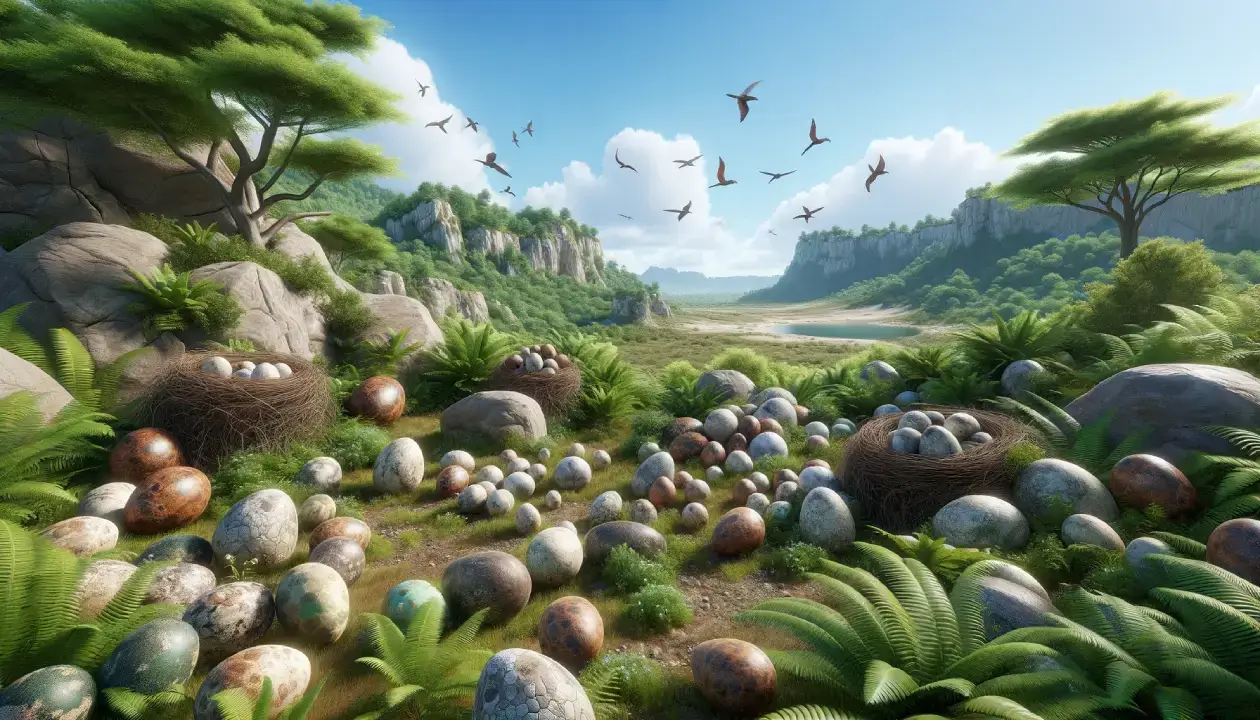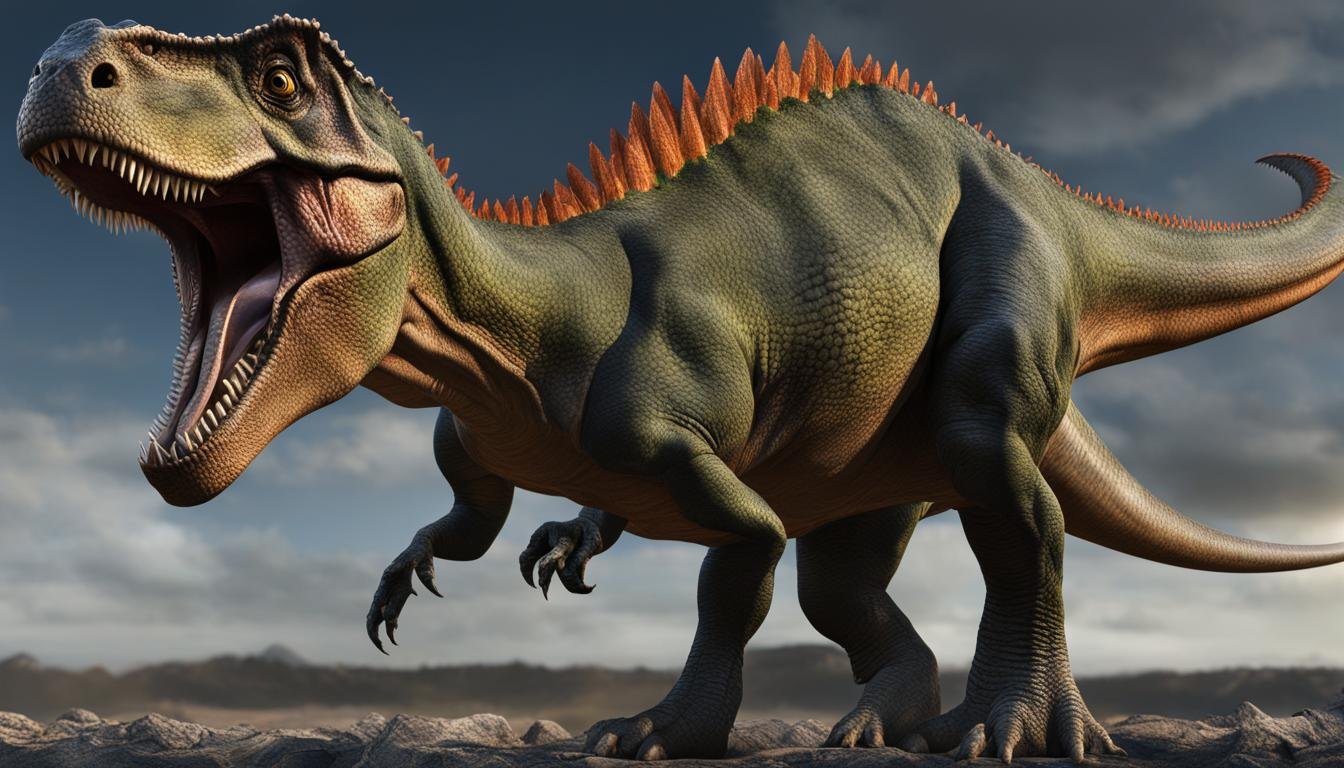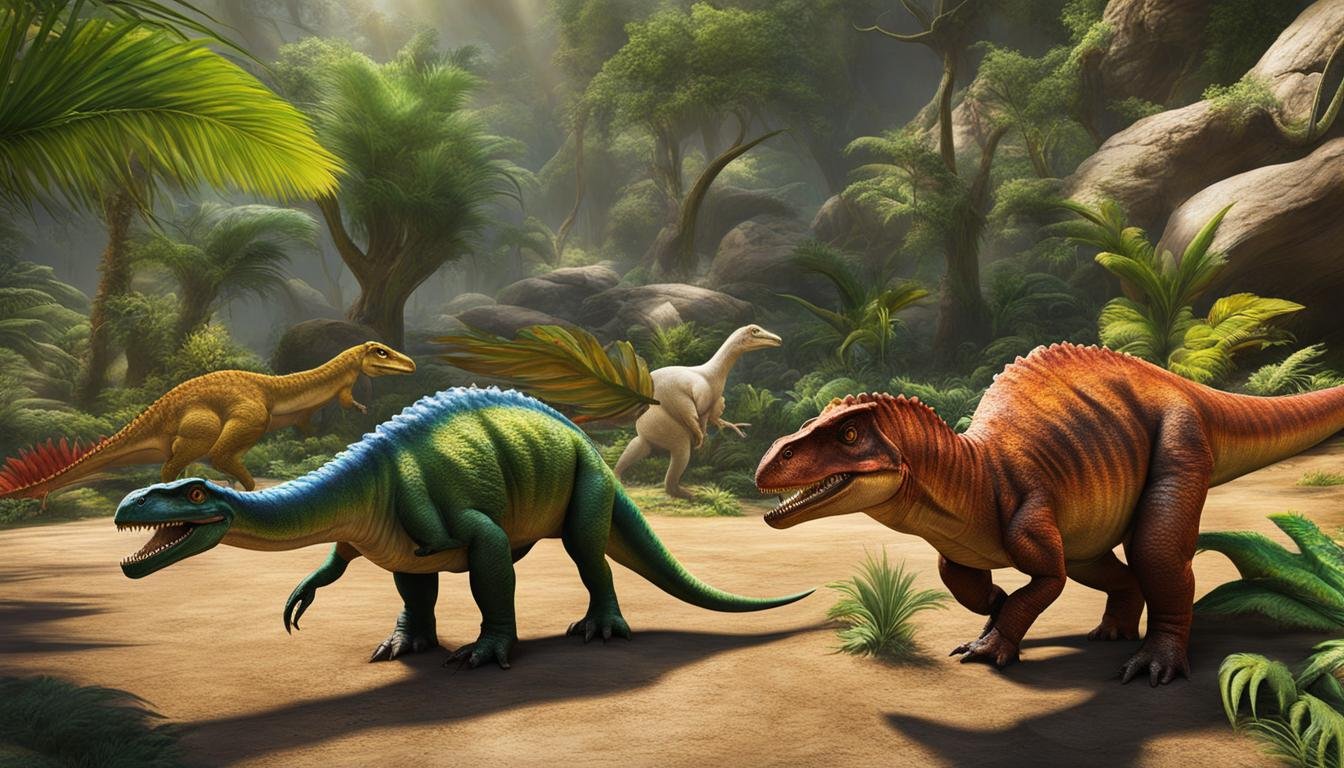Welcome to the fascinating world of dinosaur eggs and nesting sites. These remnants from the prehistoric era hold many mysteries that researchers are still uncovering today. By studying fossils of dinosaur nests and eggs, we can gain valuable insights into the behavior and reproductive patterns of these ancient reptiles.
Dinosaur eggs and nesting sites provide a window into prehistoric life, allowing us to learn more about the dinosaurs that roamed the earth millions of years ago. The fossils of these nests and eggs offer valuable clues to how dinosaurs laid and cared for their young, as well as their social structures and nesting habits.
Key Takeaways:
| Key Points | Takeaways |
|---|---|
| Significance of Dinosaur Nests | Dinosaur nests provide valuable insights into the reproductive behaviors of these ancient creatures. |
| Types of Dinosaur Eggs | Dinosaur eggs varied in size and shape, offering clues to the diversity of dinosaur species and their habits. |
| Nesting Behavior of Dinosaurs | The study of nesting behavior helps understand the social structures and care patterns of dinosaurs. |
| Discovery of Dinosaur Nests | Discoveries of nests around the world shed light on dinosaur habitats and their global distribution. |
| Unhatched Eggs and Hatchlings | Fossilized unhatched eggs and hatchlings give a glimpse into the early life stages of dinosaurs. |
| Colonial Nesting Behavior of Dinosaurs | Some dinosaurs exhibited colonial nesting, indicating complex social behaviors and survival strategies. |
| The Fossilized Dinosaur Eggs of Central India | Eggs found in the Narmada Valley provide unique insights into the health and environment of dinosaurs. |
| Clues to Dinosaur Reproduction | Comparing dinosaur reproduction to modern species reveals evolutionary links in reproductive strategies. |
The Significance of Dinosaur Nests
Dinosaur nests and eggs are fascinating remnants from the prehistoric era that provide valuable insights into dinosaur reproductive behaviors during the late Cretaceous period. Paleontologists study the fossils of dinosaur nests and eggs to uncover information about these ancient creatures.
Nest Fossils
Nest fossils are often composed of eggshells, shells of unhatched eggs, and remains of hatchlings. Paleontologists can use these materials to determine the type of dinosaur that laid the eggs, as well as how they laid them. Nest sites can also be valuable in determining the habitat and environment in which the dinosaur lived.
Paleontologist Findings
Paleontologists have found that some dinosaur species exhibited complex nesting behaviors. For example, some dinosaurs built nests in colonies, with multiple nests in a concentrated area. By examining the arrangement of eggs in a nest, paleontologists can also gather clues about the social structures and nesting habits of the dinosaur species.
| Nest Site | Dinosaur Species | Nesting Behavior |
|---|---|---|
| Dinosaur Provincial Park, Canada | Hadrosaurs | Colonial nesting in circular or spiral-shaped patterns with hundreds of nests found in one location |
| Jiangxi, China | Oviraptorosaurs | Single nests containing up to 40 eggs, often found near or on top of a mound of sediment |
| Central Mongolia | Protoceratops | Nests built in a shallow depression in the sand, containing up to 20 eggs with the male dinosaur standing guard nearby |
Dinosaur Reproduction
Studying dinosaur reproductive strategies is important because it can help us understand the evolution of reproductive behavior in modern animals. Comparing dinosaur reproductive strategies to those of modern birds and crocodiles can provide insights into the reproductive processes of these ancient reptiles.
Through the study of dinosaur nests and eggs, paleontologists can learn how dinosaurs reproduced and cared for their young. They can also determine how many eggs were laid, how long they took to hatch, and what happened to the hatchlings after they emerged from the nest.
“Dinosaur nests and eggs are a window into the reproductive behavior of these ancient creatures. By studying the fossils, we can better understand how they lived and evolved.”
In conclusion, dinosaur nests and eggs are a valuable source of information for paleontologists as they explore the mysteries of prehistoric life. The study of these remnants provides us with a deeper understanding of dinosaurs and their behaviors, and sheds light on the evolution of reproductive behavior in modern animals.
Types of Dinosaur Eggs
Dinosaur eggs come in a variety of shapes and sizes, from small, round eggs to elongated, cylindrical ones. The two main types of dinosaurs that laid eggs were sauropods and titanosaurs.
Sauropod eggs were spherical in shape, with a diameter that ranged from 11 to 19 centimeters. They had hard, thick shells and were laid in a circular or spiral pattern in a clutch. Sauropods laid their eggs in large numbers, often up to 50 at a time.
| Sauropod Eggs | Characteristics |
|---|---|
| Size | 11 to 19 centimeters in diameter |
| Shape | Spherical |
| Clutch | Circular or spiral pattern |
| Quantity | Often up to 50 at a time |
Titanosaur eggs, on the other hand, were much larger than sauropod eggs, with some reaching lengths of up to 29 centimeters. They had thin shells and were arranged in a linear fashion in a nest. Unlike sauropods, titanosaurs laid their eggs in smaller clutches of up to 15.
| Titanosaur Eggs | Characteristics |
|---|---|
| Size | Up to 29 centimeters in length |
| Shape | Elongated and cylindrical |
| Nest | Laid in a linear fashion |
| Quantity | Laid in smaller clutches of up to 15 |
It’s important to note that not all dinosaur eggs fossilize. The fossilization process is rare and requires specific conditions to occur. When eggs do fossilize, it’s usually the embryonic remains inside the egg that are preserved.
By studying fossilized eggs, paleontologists can learn more about the reproductive processes of these ancient creatures and gain insight into their mating habits and behaviors.
Nesting Behavior of Dinosaurs
Dinosaurs have been extinct for millions of years, but their nesting behavior provides vital clues to understanding their reproductive patterns. By examining their behavior, paleontologists have uncovered fascinating insights into how these ancient reptiles laid and cared for their eggs during the late Cretaceous period.
Comparing the nesting behavior of dinosaurs to modern-day crocodiles and birds has provided researchers with valuable information. For example, crocodiles bury their eggs in shallow pits and care for their young, while birds incubate their eggs in nests made of twigs and grass. These behaviors suggest that dinosaurs likely had similar nesting habits.
| Crocodiles | Modern Birds | Dinosaurs |
|---|---|---|
| Bury eggs in shallow pits | Incubate eggs in nests made of twigs and grass | Had similar nesting habits to crocodiles and birds |
| Care for their young | Care for their young | Likely cared for their young |
The discovery of fossilized dinosaur nesting sites in central India further confirms the similarities between dinosaur nesting behavior and that of modern-day reptiles and birds. The nesting grounds contained 92 nests, and researchers were able to study the arrangement of eggs in detail.
“The Narmada Valley fossil park is a nesting ground where we found those 92 nests. And in those nesting sites, we have seen eggs with surfaces slipping past each other. That leads us to believe that like modern reptiles and birds, dinosaurs also had the same nesting pattern,” says Dhananjay Mohabey, a paleontologist from the Geological Survey of India.
The colonial nesting behavior of some dinosaur species has also been studied. By examining the arrangement of eggs in a nest and the presence of multiple nests in a concentrated area, researchers can uncover clues about dinosaur social structures and nesting habits.
Overall, the study of dinosaur nesting behavior has provided insight into the reproductive processes of these ancient reptiles. By comparing their behavior to that of modern-day crocodiles and birds, researchers have gained a deeper understanding of prehistoric life.
The Discovery of Dinosaur Nests
The discovery of dinosaur nests and nesting grounds is crucial for understanding the reproductive patterns of these prehistoric animals. Among the numerous sites found around the world, one of the largest nesting grounds was discovered in Guntupalli, India.
| Location | Number of Nests | Characteristics |
|---|---|---|
| Guntupalli, India | Over 200 | Found in sediment, largest nesting ground ever discovered |
| Argentina | 4 | Tiny, well-preserved 65-million-year-old nests |
| Mongolia | 15 | Well-preserved eggs and embryos from the Cretaceous period |
The largest nesting ground discovered in Guntupalli consists of more than 200 nests and is believed to be over 65 million years old. The nests were found in sediment and are considered to be a significant discovery due to the high concentration of dinosaur eggs found in one location.
Other notable nesting sites include four tiny, well-preserved dinosaur nests found in Argentina, which are believed to be 65 million years old, and 15 well-preserved dinosaur nests found in Mongolia that contained eggs and embryos from the Cretaceous period.
Unhatched Eggs and Hatchlings
In prehistoric times, some dinosaur eggs did not hatch, leaving behind a trail of clues for paleontologists. Fossilized eggs and the remains of hatchlings found in shallow pits have provided valuable insights into the early stages of dinosaur life.
These unhatched eggs can be found in a variety of sizes and shapes, ranging from elongated to spherical. Fossil eggs have revealed that some had thin shells, suggesting that they were buried soon after being laid, while others had thicker shells, indicating that they may have been incubated in a nest.
One location where many fossilized eggs and hatchlings have been found is the Dashanpu Formation in China. Here, researchers have discovered hundreds of eggs and hatchlings belonging to the sauropod dinosaur Lufengosaurus. Studies have shown that the eggs were laid in a nest and incubated similarly to modern-day birds, with adult dinosaurs brooding the eggs to keep them warm.
| Hatchery | Fossil Eggs | Dinosaur Remains | Shallow Pits |
|---|---|---|---|
| Some dinosaur species created communal hatcheries where they could lay their eggs in a centralized location. | Unhatched fossil eggs can reveal valuable information about the biology and behavior of the dinosaurs that laid them. | When dinosaur remains are discovered in close proximity to eggs and nests, it suggests that adults were caring for their young. | Dinosaur eggs and hatchlings have been found in shallow pits that would have provided protection from predators and temperature fluctuations. |
In addition to Lufengosaurus, other dinosaurs that have been found with unhatched eggs and hatchlings include the hadrosaur Hypacrosaurus and the ceratopsian Protoceratops. By studying these fossils, researchers have been able to gain insights into dinosaur life cycles, reproductive strategies, and the early stages of development.
Overall, the discovery of unhatched dinosaur eggs and hatchlings provides a fascinating look into the reproductive behavior and early life of these prehistoric creatures. The fossils found in shallow pits and communal hatcheries have offered valuable clues to the social structures of dinosaurs, as well as how they cared for their young.
Colonial Nesting Behavior of Dinosaurs
Dinosaurs were not solitary creatures; some species were known to exhibit colonial nesting behavior. This type of nesting involves multiple individuals of the same species laying eggs in a concentrated area. The eggs are typically arranged in a circular pattern, with each egg surface slipping past the next.
One remarkable example of colonial nesting behavior was discovered in the Narmada Valley of central India. Paleo-ornithologist Dr. P. Wilson and his team found a site containing 92 nests, indicating a substantial colony of nesting dinosaurs. The nests were discovered at various levels, suggesting that the colony was active for an extended period.
| Species | Number of nests |
|---|---|
| Abelisaurid | 40 |
| Sauropod | 27 |
| Theropod | 25 |
The discovery of these nests provides significant insights into dinosaur social structures and nesting habits. The distribution of eggshell fragments suggested that the nests were located close to a water source. This discovery refuted the long-standing belief that dinosaurs only laid their eggs in isolated locations. It is now clear that these creatures preferred communal nesting sites, similar to modern-day sea turtles.
Colonial nesting behavior also provided potential advantages for the dinosaurs. Coordinated nesting increased the likelihood of finding a mate and protecting the eggs from predators. The eggs could also be kept warm by the collective body heat of the animals, mitigating the risks of temperature fluctuations.
“The discovery of colonial nesting sites provides significant insights into dinosaur social structures and nesting habits.”
The Fossilized Dinosaur Eggs of Central India
The Narmada Valley of central India is home to some of the most remarkable fossilized dinosaur eggs ever discovered. These eggs are unique in their characteristics and have provided valuable insights into the reproductive behavior of dinosaurs during the late Cretaceous period.
The eggs found in the Narmada Valley are of varying sizes and shapes, with some displaying deformities and abnormalities. One of the most notable features of these eggs is the presence of pathological eggs. These eggs exhibit abnormal growth patterns and are believed to have been laid by dinosaurs with health issues.
“These pathologies may represent individual stress or disease, or they may signal larger ecological stresses that affected entire populations,” says University of Calgary paleontologist, Darla Zelenitsky.
The eggs found in the Narmada Valley also provide insight into the preservation of dinosaur remains. Unlike other fossilized eggs that are preserved in sediment, these eggs were found in shallow pits. This unique preservation allowed researchers to study not only the eggshells but also the embryonic remains inside, providing a rare glimpse into the early stages of dinosaur life.
The Narmada Valley eggs were discovered in 1983 by Indian geologist D.M. Mohabey. Since then, several expeditions have been launched to further study these fossils. These studies have revealed that the eggs belonged to a sauropod species, one of the largest dinosaurs that ever lived. The eggs are estimated to be around 65 million years old, making them an incredibly valuable source of information about prehistoric life.
| Name | Size | Characteristics |
|---|---|---|
| Deformed egg | Varies | Abnormal growth patterns |
| Pathological egg | Varies | Abnormalities associated with stress or disease |
| Preserved dinosaur remains | Varies | Rare glimpse into embryonic development |
The discovery and study of the Narmada Valley eggs has provided valuable insights into the reproductive behavior of dinosaurs. By studying the characteristics of these eggs, researchers can better understand the physical and environmental factors that impacted dinosaur reproductive success.
Clues to Dinosaur Reproduction
Dinosaur reproduction is a fascinating subject that has been studied extensively by paleontologists. By examining dinosaur eggs and nesting patterns, researchers can gain valuable insights into the reproductive behavior of these ancient reptiles, which lived millions of years ago.
Birds and Crocodiles
Modern birds and crocodiles are closely related to dinosaurs, and their reproductive strategies can provide important clues about dinosaur reproduction. For example, researchers have observed that some species of birds and crocodiles lay their eggs in communal nests, just as some dinosaur species did. These communal nests are typically small and shallow, and they consist of a carefully organized pattern of eggs.
Dinosaur Reproduction
Studies of dinosaur nesting sites have revealed that some species also engaged in communal nesting behavior. For example, researchers have discovered a nest site in the Narmada Valley of central India that contains 92 dinosaur nests. This unusual concentration of nests provides clues about the social behavior of these dinosaurs and suggests that they may have lived in large groups.
Nesting Pattern
Another clue to dinosaur reproduction can be found in the nesting pattern of some species. For example, paleontologists have observed that some species of theropods, a type of dinosaur, laid their eggs in a spiral pattern. This unique nesting behavior suggests that these dinosaurs may have been territorial and that they laid their eggs in a way that allowed them to defend their territory.
Conclusion
Exploring dinosaur eggs and nesting sites provides a fascinating glimpse into prehistoric life. These remnants from the late Cretaceous period hold valuable clues about dinosaur reproductive behaviors, social structures, and early life stages.
By studying fossilized nests and eggs, paleontologists can uncover significant insights into the lives of dinosaurs. The discovery of the largest dinosaur nesting grounds in sediment in Guntupalli highlights the importance of ongoing research in this field.
The comparison of dinosaur reproductive strategies to those of modern birds and crocodiles helps researchers understand the complexities of reproduction that existed over 65 million years ago. The discovery of colonial nesting behavior and the presence of pathological and deformed eggs provide valuable insights into these ancient reptiles.









